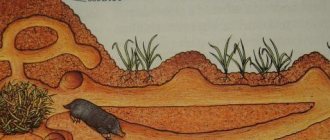A mole is an insectivorous mammal that spends almost its entire life underground. These little animals are silent and invisible, but at the same time they live almost everywhere. People often don't notice unusual animals because they rarely come to the surface.
Nature has endowed moles with unique abilities that allow the animals to live comfortably underground.
general characteristics
In the natural environment, there are several varieties of moles. The smallest representative of the species is the Sichuan shrew mole, its body length rarely exceeds 6–8 cm, its tail is from 5 to 6.5 cm, and the body weight of a mature individual is only 10–15 g. The largest mole is the Ussuri moger, length the body of a mature individual is from 20 cm, and the weight can reach up to 300 g. All moles, without exception, have characteristic features that help them survive underground.
Moles have a short, bar-shaped body, rounded at the sides.
The neck is not pronounced and seems to be a continuation of the body. If you look at the mole from above, it seems that the head grows straight from the shoulders. The shape of the head is cone-shaped, wider at the back of the head with a well-defined narrowing towards the nose.
The animals' ears are vestigial without an auricle. The location of the ear canals is determined by the presence of a skin ridge. In some varieties, the kalik is almost invisible under a layer of wool. The nose of moles is narrow and protrudes strongly above the lower lip; it is mobile and sensitive. The nostrils are wide, located on the sides, but directed forward.
Usually the mole's nose is not covered with hairs, with the exception of long, sensitive whiskers.
Unlike other varieties, the nose of the star-nosed mole ends not with an ordinary lobe, but with unique star-shaped skin outgrowths. They are soft, sensitive and similar to earthworms, the number of outgrowths is about 22 pieces.
Underground life has left its mark on animals. The moles' eyes have lost their intended purpose and are almost completely hidden under the skin. In some species, such as Caucasian moles, the eyeballs can only be seen on an x-ray. In others, the size of the eyes does not exceed the diameter of a poppy seed. Sometimes the eyes are equipped with a regular eyelid, which protects them from dust and soil. But some varieties have small slits in the skin opposite the eyes.
Elena
Ask a Question
Question to the expert
How do moles navigate underground?
Moles cannot see, but they have a well-developed sense of smell and hearing. They are able to smell or hear prey under a thick layer of earth. Animals also navigate thanks to sensitive vibrissae on the nose and tail.
Moles are quite toothy creatures, depending on the species they have maybe 34 to 44 well-developed, sharp teeth. They help hold nimble prey and chew food.
Subterranean mammals communicate with each other using various sounds. They may squeak, hiss or squeal.
Moles have strong and well-developed forelimbs with five-toed paws.
Each toe has a thick, blunt claw designed for digging. The claw is slightly curved outward, and on the inside there is a small depression that allows you to better grip the ground when digging tunnels.
There are no membranes between the fingers, but the hands are wide, spade-shaped and with the palms turned outward.
Under the ground, moles can move forward with their heads or tails. Moreover, the speed in both cases is the same. The fur on the animal's body is located in such a way that it does not interfere with movement. The wool easily bends in the desired direction.
The hind limbs are long, thin and somewhat reminiscent of rat paws in structure. The hind legs have claws, but they are much smaller than the front ones. The tail of moles is quite long, from 2 to 10 cm, its size depends on the type of animal.
Moles are very good swimmers. During a flood, small animals are able to swim across even a strong stream or a small river.
The entire body of animals is covered with soft, dense fur.
The wool grows perpendicularly and has special constrictions in the core. This allows the hairs to bend in any direction and makes it easier for the animal to move underground. Surprisingly, the fur of moles practically does not get dirty; fine debris and dust do not penetrate deeply, but settle at the very ends of the hairs. Therefore, it is enough for the mole to shake itself to clear the soil from its coat.
The color of the coat depends on the type of animal and its habitat. In the natural environment you can find black, dark brown, gray, dark red moles with different shades of fur.
Molting among underground inhabitants occurs 3–4 times a year.
Moles can shed both in the off-season and in the summer. This feature is due to the fact that animal fur quickly wears off from contact with rough surfaces. That is, in fact, the mole constantly renews its fur coat and only in winter does molting not have a pronounced character. Areas of skin where there is no hair become dense and darken. The remaining hairs are quickly wiped off, and new ones grow in their place.
The first molt of moles begins from April to June. Usually the females molt first, followed by the males. The second molt occurs already in July, in adults the spring coat changes to summer, and in young animals the baby coat comes off and an “adult” coat grows. The third autumn moult begins almost without interval; it is well expressed and occurs very quickly. The thin summer coat changes to a thick winter coat. During this period, animal fur is considered the most beautiful; it shines, shimmers, and becomes velvety to the touch.
Question to the expert
Is it possible to have a mole as a pet?
Moles cannot live in captivity. It is important to consider that the animal spends most of its life underground. Therefore, only professionals can provide an unusual pet with comfortable conditions.
Noise repellers
Moles have very sensitive hearing; loud sounds frighten and irritate animals. Therefore, the most popular and effective method of control is sound and ultrasonic repellers. These devices look like pins that need to be stuck into the ground in places where moles are detected, since the vibrations travel well through the soil. Such repellers can also be effective against rodents and snakes.
As a free alternative, you can use the folk method - a battery-powered radio, which is placed in a waterproof bag on the molehill. True, unlike special repellers, this method can affect not only moles, but also neighbors.
Habitat
Moles live almost all over the world, with the exception of those areas where the ground is unsuitable for digging and cold areas where the soil freezes to great depths. Representatives of the underground world can be found in Europe and Asia. On the Asian part of the mainland, animals are found in the Caucasus, Turkey, China, Mongolia and Indochina. The only exceptions are the southern regions. On the American continents, mole populations are found in southeastern Canada, Mexico, and almost all central and eastern regions.
Mole populations are found only in areas suitable for their existence.
Animals prefer loose soils. They never settle in wetlands. The main condition is the availability of food supply; the more food, the more animals can gather in one area. Populations usually inhabit clearings, forest edges, non-water meadows and agricultural fields.
Musteluns
The family Mustelidae (mustelidae) includes species such as badgers and weasels that prey on them. These animals are part of the largest family of carnivores. Many individuals of this species spend the vast majority of their lives underground. They are experienced diggers. They live in holes, which they dig themselves, and often end up in underground tunnels, where they don’t mind hunting.
Badgers and weasels share similar habitats and geographic distributions to moles, and small mammals make up the majority of their diet.
What do they eat?
The diet of most varieties consists of earthworms, slugs, snails, insects and larvae that hide underground or in dead leaves. But starfish, in addition to their usual food, can feed on small fish, shellfish and other underwater creatures. And mogers supplement their menu with butterflies and caterpillars. In addition, many varieties include plant foods in their diet.
On average, moles feed 5 to 6 times a day.
After each meal, the animals curl up into a ball and fall asleep. Sleep lasts from 3 to 4 hours, the mole spends this time digesting food. In one meal, the animal eats about 20–30 g of worms and insects; per day, the amount of animals eaten can exceed 90–100 g. In the summer, the amount of food eaten increases, as the heat speeds up metabolism.
Moles have a high metabolism, so they must eat a new portion every 14–17 hours. If the animal does not find food, it may die of hunger.
After the mole catches the worm, it eats it whole or tears it into small pieces. But before eating, the animal always squeezes the earth out of the worm’s body.
The benefits of moles
The mole is an excellent digger! By laying its tunnels underground, it drains the soil, helping the earth to “breathe.” By turning over the soil, moles enrich the upper layers with minerals found in the lower ones. Along the way, this underground resident destroys all harmful insects and their larvae. The mole's food includes slugs, wood lice, flies, ants, mole crickets and many other pests that spoil fruit-bearing and ornamental plants. Therefore, if your summer cottage or garden plot is a garden with overgrown trees and you do not need to worry about the fate of the newly planted tomato seedlings or rare flowers in your flowerbed, then the mole is more likely your friend than your enemy.
Lifestyle and character traits
The mole's entire life is spent underground. Animals very rarely leave their tunnels and come to the surface.
A massive emergence of moles can only be observed during the breeding season or spring flood.
Lifestyle
Moles dig long but shallow passages, rotating around their axis and spreading their paws. If the move is shallow, then a small roller appears above the surface, and all the earth is compacted. But when constructing permanent tunnels at a depth of 15 cm, the mole throws excess soil to the surface.
A pile of earth around the entrance to the labyrinth can reach a height of 50 to 80 cm and is called a molehill.
Elena
Ask a Question
Question to the expert
Do moles hibernate?
Moles do not hibernate, but in winter they practically do not appear on the surface. They stock up and eat from their pantries all winter. But animals can make tunnels under snow and fallen leaves in search of additional food.
Character and habits
Moles are famous for their thriftiness. Animals build pantries in their tunnels and store food in them in winter and summer. Most animals have several storage rooms, in case they have to leave their main home.
Moles do not dig a hole every time they go in search of food. Usually the worms themselves crawl into dug tunnels based on the musky smell and heat that the underground animal gives off.
Underground inhabitants lead a solitary lifestyle and unite in pairs only during the mating season. Moles are very quarrelsome and jealously guard their territories from outsiders. They mark the boundaries of their possessions with an odorous secretion that accumulates on the fur in the abdomen area.
Natural enemies
Moles don't have many enemies. A specific smell saves them from predators. Sometimes they can still be caught by birds of prey. This happens during spring floods. The animals' enemies are martens, wild boars, badgers, foxes, and raccoon dogs.
The only predator that is the main enemy of the mole is the weasel. She happily sneaks into their passages and catches them. The weasel does not even disdain the musky smell of a mole, which other animals do not like so much.
During the rutting period, the weasel makes a sound that moles always recognize and, sensing danger, run away. Droughts and waterlogging can kill moles. People are also the cause of the death of these animals, as they are capable of killing them either accidentally or intentionally.
Return to content
Reproduction and raising of offspring
In most cases, the timing and duration of the mating season depend on the species and habitat.
Moles, depending on the species, reach maturity a few months after birth or a year later.
Mating season
On average, the mating season begins at the end of March, but some individuals mate underground while there is still snow on the surface. Therefore, the timing of the birth of cubs can vary significantly. In addition, young females go looking for a mate later than adults.
During the mating season, moles leave their underground shelters. Females usually do not go far from their tunnels and wait for a male to appear in their territory. Males, on the contrary, actively move in search of a partner and are guided by smells and sounds.
Lifespan
You need to know the enemy by sight.
The mole in nature has many enemies. These are all kinds of predators, such as:
- foxes;
- cats;
- raccoons and raccoon dogs;
- ferrets;
- caresses;
- martens;
- hedgehogs;
- storks;
- owls;
- hawks;
- crows.
Any of the listed creatures, if they do not eat moles, can easily kill the animal on occasion, like dogs or domestic cats. But birds and mustelids, especially the little weasel, are among those who eat animals. The weasel can even chase an underground digger into his own tunnel.
Well, we must not forget about the very tense relationship between man and this animal. It’s also worth saying here that moles always live alone, and the penetration of an uninvited guest into someone else’s territory can also end very badly for him.
In general, this animal lives 4-6 years, if you're lucky. Which happens extremely rarely, as with all wild animals. Most often, the animal can live for 2-3 years, after which, one way or another, it meets its end.
OUR READERS RECOMMEND!
To get rid of rodents, our readers recommend the Pest-Reject repeller
. The operation of the device is based on the technology of electromagnetic pulses and ultrasonic waves! Absolutely safe, environmentally friendly product for humans and pets. Read more here...
Interesting Facts
Moles are unique and amazing creatures in their own way. But it is not recommended to have an unusual animal at home. Because not every professional can create conditions for a comfortable life.
Many interesting facts are known about moles, however, they are considered an incompletely studied species. This is due to their specific habitat.
Interesting Facts:
- Moles, like all underground inhabitants, are very sensitive to vibration. Their behavior can predict disasters such as earthquakes, volcanic eruptions and landslides. In general, everything that is connected with the movement of the earth's layers.
- Molehill soil is an excellent source of fertile soil for garden beds. It does not need to be sifted, it is airy and loose.
- Some Danish archaeological scientists use moles in excavations. Small and very hardworking creatures push to the surface everything that prevents them from digging a tunnel. Including archaeological finds.
- The word "mole" is used to describe secret agents in intelligence organizations. People of this profession, like moles, must have the ability to quietly infiltrate any structure.
- Dirt and dust do not stick to mole fur. It is enough for the animal to shake itself off to get rid of small debris.
- In the cartoon “Thumbelina,” the old mole took his bride to the storerooms with a large supply of food. In real life, moles are indeed famous for their thriftiness. Their tunnels are used for food storage.
- Mole passages lie at shallow depths, but can be from 100 to 200 meters in length, which is several hundred times greater than the size of the animal itself.
- There is a bone in the external genitalia of males.
- Moles do not hibernate, but since it is very difficult to find food in cold weather, they make impressive reserves.
- Contrary to myths and rumors, all moles have eyes. It’s just that in some animals they are located under the skin and are visible only on x-rays. In most cases, the small eyes are hidden behind small slits in the skin or eyelid.
- Like all small animals, moles have an increased metabolism. Therefore, animals must eat almost constantly. An adult animal can eat an amount of food equal to its own weight per day.
- The animals do not live in captivity and are not tamed. At one time they tried to breed them to obtain soft skins, but the idea quickly failed.
- In the USSR, moles were hunted for their skins. Every year the population decreased by several million individuals. Currently, mole hunting is prohibited.
- In loose soil, a mole can dig a meter-long tunnel in 3–5 minutes.
- According to statistics, moles destroy about 1% of crops worldwide. Basically, they do not eat plants, but their active underground activity leads to damage to roots and death of crops.
- A mole's mouth has more teeth than a human's. Depending on the variety, the number of teeth can be from 34 to 44 pieces.
- Moles molt 3-4 times a year.
- In addition to the main food pantries, each mole has an additional warehouse in case something happens to the main one.
- Moles see practically nothing. But animals have very sensitive hearing and a well-developed sense of smell.
- Some moles are excellent swimmers and can even swim across a stormy stream. And such a species as the starfish is capable of diving and preying on underwater inhabitants.
- On occasion, moles may dine on a small mammal or bird.
- Moles' fur grows straight up without tilting. But each hair has a constriction in the central part, this allows it to bend in different directions.
Harm from moles
The harm from a mole living on your territory begins when you actually feel it. This could be destroyed seedlings, root vegetables damaged by claws, or a torn up flowerbed that you worked on decorating all spring. Other potential harm from moles is usually greatly exaggerated. So, for example, a mole is accused of eating worms that improve the fertile layer of soil. However, we should not forget that worms also reproduce - nature itself regulates food chains - this process is always under its strict control, so even the most voracious mole will not eat all the worms in any case.
We must also take into account the fact that while one mole lives in your garden, others will not appear in it - solitary moles always jealously guard their loneliness and do not tolerate competition. And, finally, we need to remember that the lifespan of moles is very short, not to mention the fact that they also often change their place of residence for some reasons unknown to us. It is quite possible that the few piles of earth that the mole threw to the surface that frightened you will be the only and one-time “trouble” that this dungeon dweller brought you, who is trying, unless absolutely necessary, not to advertise his presence and not to attract close attention to himself. But if you still cannot come to terms with the fact that “someone is digging under you” and this greatly interferes with your life, then there are quite a lot of proven ways to expel an unexpected settler from your land. Everyone has the right to fight for their territory.
Starfish
Known under the names star-nosed mole, star-nosed mole, star-nosed mole, star-nosed mole. In appearance it is similar to most other moles, but differs in its elongated tail (6–8 cm) and hard fur that does not get wet. There are two skin growths on the face, similar in appearance to an asterisk, which is where the name of the individuals comes from. Animals in adulthood weigh up to 85 g. The eyes are small, but clearly distinguishable in appearance. Lives in the eastern regions of North America.
Western American
The body length of the animal is 11–14 cm, while the tail can take up to 5.5 cm. Body weight reaches 170 grams. The proboscis of the muzzle is moderately elongated. The eyes are small, hidden under the fur. There is no external auricle. The hand of the foot is very wide. The tail is thick, covered with sparse hairs. Distributed in North America.
Short-faced
A small species of the Mole family. Lives in China.
Long-tailed
Lives in Asia. Body length 7–9 cm, weight up to 12 grams. There are no auricles. The front legs are slightly widened and equipped with almost straight claws.
Chinese shrew
Distributed in the Chinese province of Sichuan. It lives mainly in forests of the temperate zone.
Caucasian
Outwardly, it almost completely resembles a European mole. It stands out only for its rudimentary eyes covered with thin skin. It has large teeth and velvety fur. It can burrow to a depth of 1 m. It eats up to 40 g of food per day.
Blind
The smallest mole in our country with a body length of 8–12 cm, weight – no more than 30 grams. The eyes are covered with thin skin. Tail length is about 3 cm.
Japanese mogera
It lives in the southern territories of Japan, as well as in China, Korea and the south of Primorsky Krai. Prefers to live in cultivated fields and meadows.
Pipe trap
You can buy special traps for moles in stores, but they injure or even kill the animal. An equally effective, but at the same time humane alternative is pipe traps, which allow you to catch a mole without harming it.
Tube traps are placed in the mole tunnel. When the animal passes through it, it gets stuck in the pipe. Then the trap needs to be pulled out and the mole released away from human habitation. Best of all - in a field, in a river floodplain, on the edge of a forest or in a deciduous forest. The soils of coniferous forests are too hard for it.
We must remember that the mole needs to eat constantly; just 14 hours without food can lead to the death of the animal. Therefore, traps should not be left for more than one day. Most often they are placed at night.
Main varieties
The classification of moles implies the existence of over 40 species. Among them, the most common are about one and a half dozen subspecies.
East Asian
Animals from the Mole family. They are found in mid-mountain meadows and forests of East and Southeast Asia. Little studied, do not have well described characteristics.
Mogers
Moles with a body length of 9–25 cm and a weight of 290–300 grams. They differ from their relatives of other species in their brownish-brown hair, the specific structure of the auditory apparatus and pelvic bones. There is no fang in the lower jaw. The eyes are covered with leathery membranes and are not visible from the outside.
Ordinary
The animal is known as the European mole. It has a rounded oblong body, an elongated muzzle and a short neck. The limbs are small, adapted for digging. The front legs end in spade-shaped palms that are turned outward. They have powerful claws.
The eyes are partially covered with skin. The hairline is thick and short. This genus is most common in the Mole family.
American shrew
The most popular species of mole in North America. Their habitat is wet areas. They have soft and dense fur. The tail is long, equal to half the body. The length of the animal itself is about 10 cm, weight – 10 grams. The eyes are small, the paws are less adapted to digging than those of other subspecies. The animal can swim and climb bushes.
Hairy-tailed
Another American-Canadian species of moles. The animals weigh 50 g and have a body length of 3.5 cm. The head is strongly elongated. The upper incisors are better developed than the other teeth. The animal sometimes crawls out to the surface of the ground at night.
Whitetail
A representative of Moles, distinguished by its white tail. In general, it looks almost like all other moles. Found throughout Bangladesh, India, China and Myanmar.
Eastern American
A large mole, 16 cm long and weighing 75 g. The front legs are wide and powerful, well suited for digging. There is no hair on the paws. Their width is greater than their length, the hind and front toes are fused.
Western Chinese
The most original type of mole in China. It lives in the provinces of Gansu, Qinghai, Shaanxi and Sichuan.
Review of popular brands
Manufacturers offer various remedies for moles and shrews on the site: tablets, poisonous baits, ultrasonic repellers. The most popular of them are:
"Dakfosal"
The fumigation insecticide begins to emit heavy gas upon contact with the soil, spreading throughout all passages, penetrating into hard-to-reach places. Two to three tablets are placed at maximum depth. The hole is filled with earth.
DETIA
DETIA with essential oils, safe for people and soil, but effective against moles. The balls are buried at a distance from each other in the hole. Poisonous toxins immediately begin to evaporate. To achieve results, the procedure must be repeated at least 2 times per season.
"Russian Trap"
Bait in the form of paraffin briquettes is used to expel shrews, moles, rats, and mice from a summer cottage. Contains: active brodifacoum and fragrances with a suffocating effect.
ARGUS (gel)
One tube (30 g) is sufficient to distribute at the entrance to each burrow. The active substance is brodifacoum. Causes paralysis.
"Alphos Krot"
An effective drug against moles, hamsters, and gophers. It releases alphos (heavy gas), which gradually displaces air, settling to a soil depth of 3–4 m. The drug will not leave behind new mole spots after 7–10 days. Animals will become afraid and leave the area. For use:
- scatter around the area, throw into holes;
- sprinkle with earth.
The result can be observed within 20 hours after use.
The tablets are used according to the instructions. Do not open the packaging indoors.
"Stop the Mole"
A toxic chemical with migratory properties that quickly fills burrows. 2-3 tablets are placed in each hole and covered with earth. It is better to carry out procedures during the day (from 12:00 to 16:00). Predators immediately leave the dug up areas.
Reference! It is not recommended to throw tablets into holes after rain, or to inhale the gas released.
"Green House Antikrot"
Poisonous gel concentrate is a poison against shrews and moles in a summer cottage. Contains active bromadiolone. One treatment with placing 15 grams into a mole hole is enough, and the desired result will not take long to arrive.
"Antrokot" is a good remedy with a long-lasting effect and is affordable. Eliminates entire populations of rats, mice, moles. Although, according to the instructions, you have to breed the bait yourself.
Scented repellers
The mole has well-developed not only vision, but also a sense of smell. Therefore, one of the most popular folk methods of fighting moles is to place substances with a strong odor in the tunnels. Recommended to use:
- coffee grounds;
- rags soaked in gasoline or fuel oil;
- spoiled fish and rotten eggs;
- hot peppers;
- garlic;
- Castor oil.
Stores also sell special aromatic granules that need to be scattered on the ground and watered with water or poured into mole tunnels. But all these methods are ineffective - when faced with an unpleasant odor, the mole simply blocks the tunnel through which it penetrates and digs a new one. Unlike vibrations, odors do not spread through the thickness of the earth.











